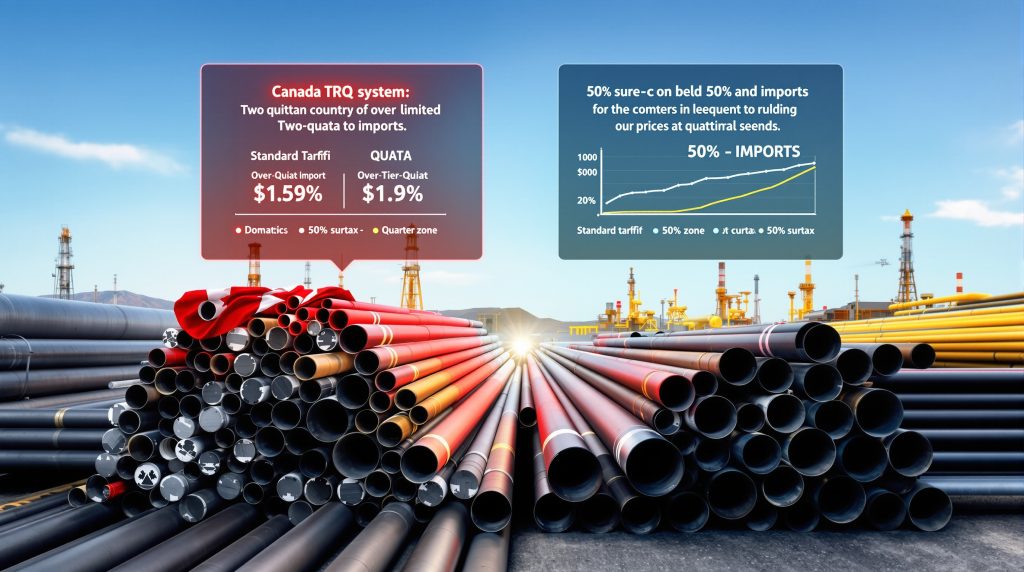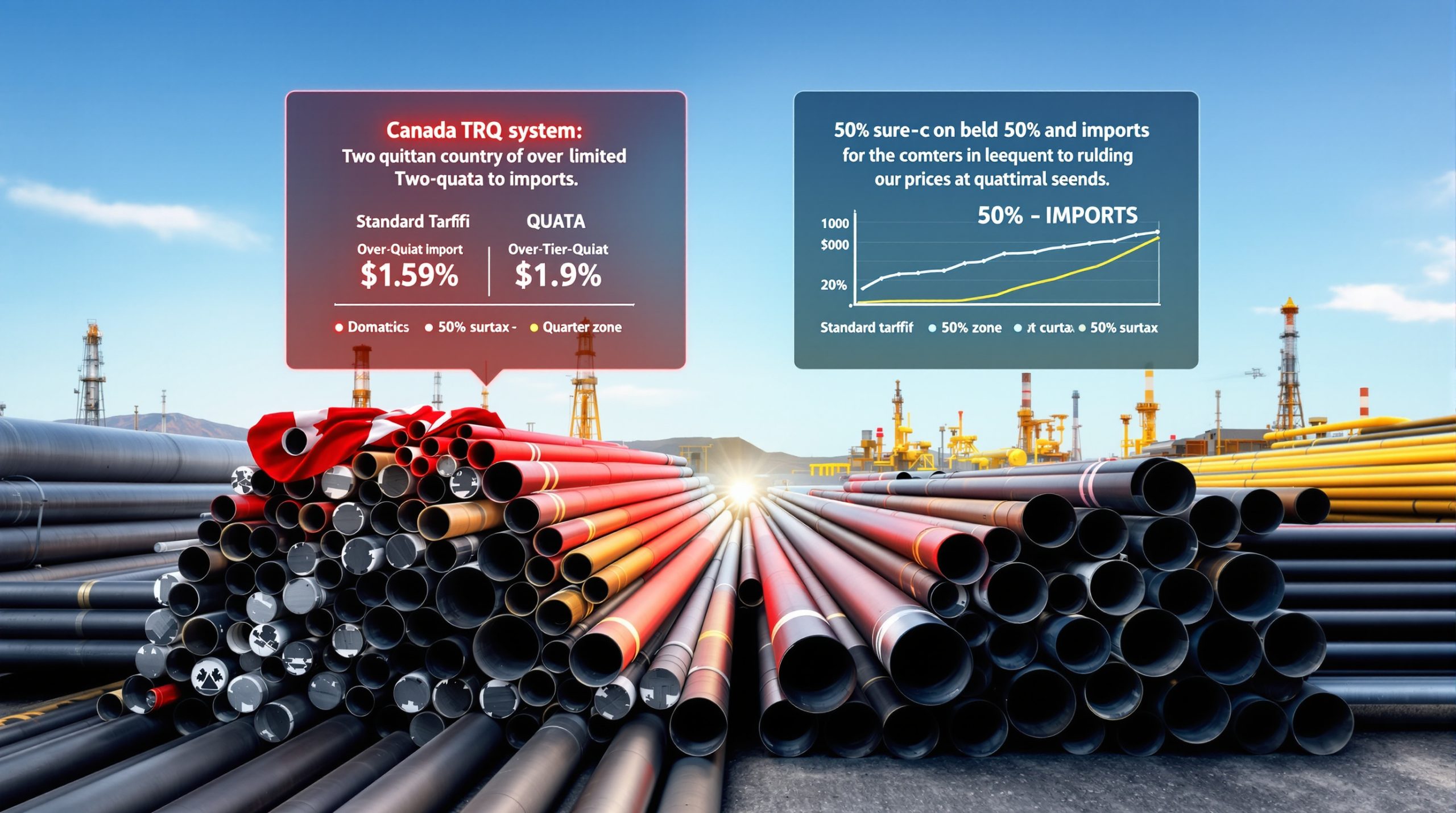Understanding the Basics of Canada's TRQ Framework
Canada's tariff rate quota (TRQ) system represents a significant shift in how oil country tubular goods (OCTG) and linepipe are imported and distributed throughout the Canadian market. This framework establishes specific import volume limitations with substantial financial penalties for exceeding those thresholds, creating a new competitive environment for industry participants.
Implemented in mid-2025, the TRQ framework followed a two-phase approach:
- June 27: Applied to non-Free Trade Agreement (FTA) countries
- August 1: Extended to FTA exporters (excluding the United States and Mexico)
This staged implementation provided market participants with a transition period while clearly signaling Canada's commitment to protecting domestic steel production capabilities in the long term.
According to industry data from the Canadian Border Services Agency (CBSA), the primary goal of this policy is to shield domestic OCTG and linepipe producers from diverted steel flows resulting from US tariffs on Canada while ensuring priority access to Canadian-made materials for government infrastructure projects.
What Are the Key Components of Canada's TRQ System?
Quota Allocations and Distribution Method
The TRQ system establishes clearly defined quarterly import quotas that vary by product category:
- OCTG from non-FTA origins: 7,816 tonnes per quarter
- Large-diameter linepipe: 5,086 tonnes per quarter
These quotas operate on a first-come, first-served basis without country-specific allocations or designated supplier preferences. This creates a highly competitive environment where timing becomes a critical factor for importers. Early arrivals secure standard tariff treatment while later shipments face significant penalties once quarterly quotas are exhausted.
Punitive Surtax Structure
The financial penalties for exceeding quota limits create a substantial cost barrier:
- 50% surtax on all over-quota imports
- Additional 25% levy on imports containing Chinese-melted steel
This dual-penalty structure effectively limits the economic viability of certain supply channels once quotas are exhausted, forcing Canadian buyers to reconsider their procurement strategies and supply chain relationships.
How Is the TRQ System Affecting Market Dynamics?
Pricing Uncertainty and Dual-Price Offers
The unpredictable nature of permit allocations has led suppliers to implement defensive pricing strategies to manage risk exposure. Many international suppliers now issue two-tiered price quotes to Canadian buyers:
- Standard landed cost (assuming within-quota arrival)
- Premium pricing that includes the potential 50% surcharge
This dual-pricing approach effectively transfers risk management to buyers and introduces significant uncertainty into procurement planning. The inability to predict whether shipments will arrive within quota limits complicates budgeting, project timelines, and cost projections for Canadian energy projects.
Procurement Strategy Adjustments
The TRQ system has forced Canadian buyers to fundamentally reconsider their sourcing approaches:
- Accelerated purchase timelines to secure early-quarter quota allocations
- Increased focus on domestic sourcing despite potentially higher base costs
- Development of contingency plans for critical materials that may face surcharges
- Greater emphasis on inventory management to buffer against quota exhaustion periods
Impact on Non-Competing Products
A particularly challenging aspect of the TRQ system is its application to specialized products not manufactured domestically in Canada. This creates a situation where Canadian buyers must still import certain specialized OCTG products but face potential surcharges despite no competitive threat to Canadian producers.
Industry experts note this aspect of the policy has drawn criticism for increasing costs without achieving domestic production protection. The Canadian Association of Petroleum Producers has indicated this could add between 8-15% to certain specialized project costs where no domestic alternatives exist.
What Are the Current Market Conditions Under the TRQ System?
Near-Term Price Stability
Despite the structural changes introduced by the TRQ system, OCTG and linepipe prices have remained relatively stable in the Canadian market through late 2025. This stability can be attributed to several factors:
- Controlled inventory levels maintained by distributors
- Disciplined pricing strategies across the supply chain
- Limited import volumes arriving in Canadian ports
- Gradual adaptation to the new regulatory framework
The Canadian Steel Producers Association reports that domestic mills have maintained consistent pricing policies to support market stability during this transition period.
Expected Future Volatility
While current conditions reflect relative stability, industry analysts anticipate increasing price volatility as the market fully adjusts to the TRQ constraints:
- Quarter-end periods will likely see price spikes as quotas near exhaustion
- Project-heavy quarters will experience more pronounced supply constraints
- Large-diameter pipeline projects could rapidly deplete available quotas
- Qualification requirements for OCTG make substitution difficult, limiting flexibility
Market data from Canadian customs indicates quota utilization rates accelerated in the third quarter of 2025, suggesting the cushion period may be ending as supply chains adjust to the new normal.
What Are the Long-Term Implications for the Canadian Market?
Strengthened Domestic Mill Position
The TRQ system fundamentally strengthens the competitive position of Canadian OCTG and linepipe producers by:
- Creating artificial scarcity for imported alternatives
- Establishing a price floor that supports domestic production economics
- Providing predictable protection against import surges
- Encouraging long-term supply relationships with domestic mills
Industry forecasts suggest domestic mills could increase their market share by 15-20% over the next two years as a direct result of the TRQ system.
Structural Cost Increases
The system introduces several structural cost factors that will likely persist in the Canadian energy sector:
- Higher transaction costs due to increased administrative requirements
- Risk premiums built into pricing to account for quota uncertainty
- Reduced competition from international suppliers
- Limited ability to leverage global price advantages
Economic analysis indicates these structural changes could add $35-50 million annually to Canadian energy industry procurement costs, with some specialized projects seeing cost increases of 5-8% due to reduced supply options.
Supply Chain Adaptation
The industry is developing innovative approaches to navigate the TRQ constraints:
- More sophisticated quota monitoring and tracking systems
- Earlier procurement planning cycles
- Diversified sourcing strategies that balance domestic and import options
- Strategic inventory positioning to mitigate quarter-end shortages
Leading Canadian energy firms are already implementing 12-18 month procurement cycles for critical OCTG components, compared to previous 6-9 month timelines.
How Does the TRQ System Compare to Other Trade Measures?
Contrast with Traditional Tariffs
The TRQ approach differs from conventional tariffs impact investment in several important ways:
- Creates a binary cost structure rather than a uniform increase
- Introduces timing elements that affect landed costs
- Allows some imports at standard rates while severely penalizing others
- Creates unpredictable market conditions based on quota utilization rates
This structure creates a more complex competitive environment than straightforward tariff plans economic impact, requiring more sophisticated risk management approaches from both buyers and sellers.
Relationship to Other Canadian Trade Policies
The TRQ system complements other Canadian trade measures:
- Aligns with broader efforts to shield domestic steel production
- Responds to trade diversion resulting from steel tariff exemptions under U.S. Section 232
- Supports government priorities for domestic content in infrastructure projects
- Creates preferential treatment for U.S. and Mexican suppliers under USMCA/CUSMA
According to Global Affairs Canada data, the TRQ system aligns with Canada's broader industrial policy goals of maintaining strategic manufacturing capabilities while preserving preferential trade relationships with key allies.
What Should Market Participants Expect in 2026?
Increasing Impact Severity
As the market fully adjusts to the TRQ system, its effects will likely intensify:
- More pronounced price volatility as procurement patterns adapt
- Greater premium for early-quarter deliveries
- Potential development of secondary markets for quota allocations
- Increased investment in domestic production capacity
Industry forecasts suggest price premiums for early-quarter deliveries could reach 8-12% as competition for limited quota allocations intensifies.
Procurement Risk Management
Companies operating in Canada will need to develop sophisticated approaches to manage TRQ-related risks:
- Contractual provisions to address quota-related cost increases
- Diversified supplier portfolios spanning domestic and international sources
- Advanced forecasting to anticipate quota exhaustion timing
- Strategic inventory positioning to bridge supply gaps
Leading energy companies are already incorporating TRQ risk factors into their project budgeting with contingency allowances of 5-10% for specialized tubular goods requirements.
Potential Policy Adjustments
The Canadian government may refine the TRQ system based on market feedback:
- Potential exemptions for specialized products without domestic alternatives
- Adjustments to quota volumes based on market conditions
- More transparent allocation mechanisms to improve predictability
- Product-specific subcategories to prevent critical shortages
Trade policy experts suggest the first formal review of the TRQ system's impact is expected in mid-2026, with potential adjustments following based on industry consultation.
How Can Companies Navigate the New TRQ Environment?
Strategic Recommendations for Buyers
Canadian OCTG and linepipe purchasers should consider several approaches:
- Develop early-quarter procurement strategies to secure quota allocations
- Establish strong relationships with domestic suppliers as alternatives
- Implement robust inventory management to buffer against quota exhaustion
- Consider longer-term contracts with suppliers that include quota risk-sharing provisions
Industry leaders are increasingly adopting 60-90 day forward procurement windows to ensure early-quarter delivery and quota availability.
Supplier Adaptation Strategies
International suppliers targeting the Canadian market need to adjust their approaches:
- Develop transparent dual-pricing models that clearly communicate quota risks
- Establish logistics capabilities for early-quarter deliveries
- Consider partnerships with Canadian distributors to manage quota allocations
- Explore product differentiation strategies to justify premium pricing
Market data shows suppliers who have successfully developed early-quarter delivery capabilities have maintained market share despite the TRQ constraints.
Monitoring and Compliance Considerations
All market participants should implement systems to track:
- Real-time quota utilization rates
- Shipment timing relative to quota availability
- Documentation requirements for origin verification
- Potential exemption opportunities for specialized products
Companies that have invested in real-time TRQ monitoring systems report 30-40% better quota success rates than those relying on manual tracking processes.
FAQ: Canada's TRQ System for OCTG
What products are covered by Canada's TRQ system?
The system covers oil country tubular goods (OCTG) and linepipe, with specific quota allocations for different product categories and origins. This includes casing, tubing, drill pipe, and large-diameter linepipe used in energy production and transmission.
Are any countries exempt from the TRQ system?
Yes, the United States and Mexico are exempt from the TRQ system under the USMCA/CUSMA agreement provisions, reflecting Canada's commitment to North American trade integration.
How long will the TRQ system remain in place?
The Canadian government has not specified an end date for the TRQ system, suggesting it will remain a long-term feature of the market. Industry consensus suggests a minimum 3-5 year implementation period before any major policy revisions.
Can companies apply for exemptions for specialized products?
Currently, the system does not provide specific exemptions for specialized products, though this could change as the policy evolves. Industry associations are actively lobbying for specialized product exemptions where no domestic alternatives exist.
How are quotas monitored and tracked?
The Canadian Border Services Agency (CBSA) manages quota tracking through import permit applications, with real-time utilization rates available through official channels. Companies can access updated utilization data through the CBSA's electronic tracking system.
Further Exploration
Readers interested in learning more about trade policies affecting the oil and gas supply chain can explore additional resources through industry associations such as the Canadian Association of Petroleum Producers and the Canadian Steel Producers Association, which offer detailed analyses of market impacts and adaptation strategies.
Industry experts recommend closely monitoring both quarterly quota utilization rates and domestic production capacity expansion announcements, as these will serve as leading indicators of future market conditions under Canada's TRQ system for oil country tubular goods.
Want to Catch the Next Major Mineral Discovery?
Discover why significant ASX mineral discoveries can lead to exceptional market returns by exploring Discovery Alert's dedicated discoveries page, powered by the proprietary Discovery IQ model that transforms complex mineral data into actionable insights. Begin your 30-day free trial today at Discovery Alert to position yourself ahead of the market.




